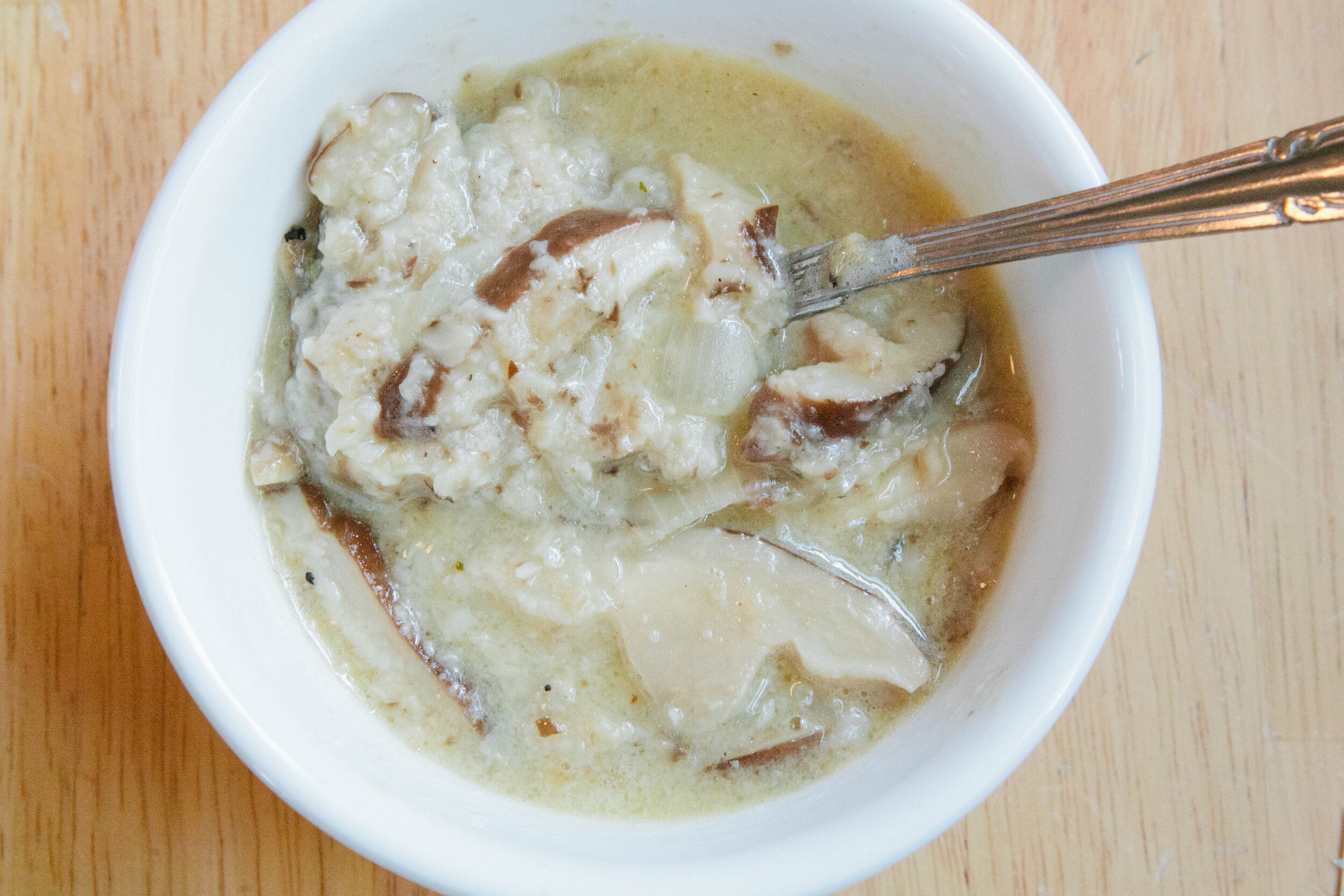I have made a lot of soup in the last seven years. For a long time, I was fine with a simple soup of onions, chicken, stock soup over and over and over...until I wasn’t! I longed for soups that were full of flavors and textures and that were interesting to my body but still nutritious.
Good soup is a great way to gets lots of nourishing food. It’s an essential part of the GAPS protocol because of it’s healing properties. Most of the digestion work is done for you already when soup is simmered for a long time. Nutrients are allowed to come of the protein or fiber where they are bound as free floating amino acids, vitamins, and minerals are all released. This makes them easily digested and able to be used and absorbed by our bodies quickly. Amino acids and collagen from meat stocks and meat are helpful to heal a leaky gut and help our organs be fed. Vegetables and salts add a lot of trace minerals.
Sometimes we don’t have everything we need for a particular soup recipe. Or we might get stuck in a rut, making the same recipe over and over. Variety is the key to success with soups because it’s easy to get bored. There’s a helpful algorithm to making soup. It will help you learn how to think through making a soup creatively.
Download my pdf on Making Soup Without a Recipe here to keep for later. You can also watch the video below on how to cook soup without a recipe.
If you were never taught cooking or aren’t comfortable in the kitchen, you might think you’re behind and unable to cook without a recipe. Fear not! There are many resources to help you get more comfortable. Look to others. Take cooking classes. And most of all, cook! The simple act of cooking and experimenting with your food will help you become more comfortable with creating meals without a recipe.
The basic components of a soup are:
Meat Stock or Bone Broth (we’ll talk about the difference below!)
Meat
Vegetables
Fat
Salt
Peppercorns
Herbs and/or Spices
Let’s go through them step by step.
Meat Stock and Bone Broth
I almost always recommend meat stock over bone broth. The primary difference between the cooking of meat stock and bone broth is the ratio of meat to bone and the cooking time. Meat stock has a short cooking time and a ratio of 80/20 meat to bone. Bone broth has a longer cooking time and a ratio of 20/80 meat to bone.
Meat stock heals and seals the gut lining and reverses inflammation to complete the gut healing process. Bone broth is totally fine to eat once your gut is healed. It also has many minerals in it like meat stock. However, it also has high glutamic acid which can be neurologically irritating, which might cause migraines or joint pain among other things. Once your gut is healed, bone broth is a great way to reuse meat stock bones which helps with sustainable eating and eating well on a budget.
I recommend an adult eat 3-6 cups of meat stock a day if they are healing and a child 1-3 cups a day. You can of course have more if your body wants it. Getting 3-6 cups in a day can be difficult. Soup is a great way to consume meat stock! (See more ideas for consuming meat stock here.)
Any meat can be used for stock. Find good sources for your meat if you can. Beef, poultry, and seafood are all great choices but also try bison, rabbit, or duck. Even bear! Any game meat does tend to have a stronger taste so I would recommend using it for a more heavily flavored soup.
My preference is to choose meat and joints from the same animal when I make my stock but you can certainly mix and match if you need to.
To learn to make your own stock step by step, click this link or watch me make it below!
Meat
The meat you use can be deboned meat that was already cooked in your stock since it’s not cooked for very long or it can be fresh meat.
Meat can also be seared in good fat before you add it to a recipe to add additional flavor. If you’re following the GAPS Protocol, wait until Stage 4 before eating seared meat.
You can also add ground meat, either loose or made into meatballs. (Flavored or not!) Get a recipe for meatballs here. Fish and shellfish can also be added but be sure you don’t overcook them.
Be sure to add skin and cartilage back in with your meat! That’s the good stuff.
If you’re following the GAPS Protocol, make sure you are not using too much muscle meat, like a chicken breast or thigh. Muscle meat on its own is very low in nutrition and be constipating.
Vegetables
Any vegetable is a good vegetable for most of us! IF you are following the GAPS Protocol, refer to the Allowed/Not Allowed vegetable list in the yellow GAPS Diet book. If you are No Plant GAPS, avoid vegetables.
There are two times you can add vegetables to a soup. The first is when you make your stock. Or you can wait to add vegetables when you make the soup itself. You can also reuse your vegetables from your stock if you like well cooked vegetables.
If you have any issues with bloating, cramping, ulcers or bleeding, avoid vegetables with a lot of fiber or starchy vegetables. (Celery might not be a good choice for you, for example…)
Experiment with what vegetables you like in your soup! You can also sear your vegetables in fat before you add them to the soup for more flavor. Be sure to add the fat into your soup that you cook your vegetables in. Eggplant, for example, absorbs a lot of fat so they will continue to absorb the fat while they are cooked in the soup.
Fat
The most healing healthy fats are mostly animal fats, like lard, tallow, butter, sour cream or creme fraiche, and ghee.
Eat as much fat in a day as you want and can tolerate. I recommend 1/2 cup per day. Work your way up gradually. If you experience issues like burping, nausea, headaches, etc. it probably means your bile is not moving fast enough to help digest the fat. Beet Kvass is a great way to help with this! Learn to make it here!
Bad fats are rancid oils, canola oil or other poorly processed oils, soy bean and peanut oil. Your body doesn’t know what to do with these fats.
To learn more about fat, click here.
Salt
Salt makes food taste GOOD but we also need salt for our bodies to function! Our immune and adrenal systems need minerals to function, which is what real salt is. Detoxification processes and our brain also require a lot of minerals!
When I talk about salt, I’m not talking about sodium chloride. That’s not salt! Everything “bad” about salt is true if you are eating sodium chloride.
A good, real, whole salt is where we get a lot of these minerals. It’s important to eat a variety of sea salts. From my understanding the highest to lowest salts by mineral content are Baja Gold Sea Salt, Celtic Sea Salt, Redmond’s Real Salt, and Himalayan Sea Salt. Learn more about choosing the right salt for you below!
I always recommend having salt on the table in addition to lightly salting your food while you’re cooking. Choosing how much salt we need is an important part of listening to our bodies. Some of us need more salt than others and some days we need more salt than others! Start children on eating salt too and help them salt their food.
Peppercorns
Peppercorns can be whole or ground when they are added to your soup. You can add them to your stock or to your soup after - or both!
Whole or freshly ground peppercorns provide the highest nutritional properties. Once a peppercorn is broken or ground, the nutritional properties decrease.
Sometimes, it can be irritating to have full peppercorns. Try adding whole peppercorns to your soup while it cooks and then remove them before you eat them.
Herbs and/or Spices
It’s important to flavor your soups well to provide variety, prevent soup burnout, and make a soup delicious!
If you are following the GAPS Protocol, fresh herbs can be used on GAPS Intro Stage 1. Be sure to listen to your body. Dried herbs can be irritation so, for most people, avoid adding them until Full GAPS.
Now that you know the components, it’s time to build your soup!
Choose a flavor profile:
Research different cuisines and what their recipes include. You’re not looking for a specific recipe here; you’re simply learning what other cuisines use for flavor profiles. For example, what spices and herbs make up Indian, Greek, or Moroccan food?
Try experimenting with new herbs or spices than you normally use. This will change your soup’s flavor profile.
OR
Choose ingredients from the fridge!
What ingredients do you need to use up right now? What do you have a lot of? Sometimes, the ingredients can make the taste profile.
2. Start your stock
How much stock you need will depend on how much soup you’re going to make. I tend to cook 6-8 cups of stock at a time as a single person. I want leftovers of soup to freeze and reuse. Plus, if it’s a really great soup, I tend to eat a few cups of it in the first day!
3. Add your vegetables and meat
Generally, vegetables take longer to get soft and well cooked than meat does. Some harder cuts of meat may do better with a long simmer but generally, I add my vegetables first and then my meat. Kale, spinach, and other leafy vegetables should be added near the end because of their short cooking time.
4. Add some herbs and spices
Be BOLD with flavors if your gut can handle it! This will keep soup interesting!
5. Add some salt
Salt lightly and be sure there’s more on the table. Go light even if you’re cooking only for yourself. Some days you will want more salt than others and overly salting is a good way to ruin a soup.
6. Finish with toppings
There’s few things I enjoy more with food than topping a delicious soup with a slice of avocado or dollop of sour cream. Freshly pressed garlic is a great topping that is both anti-parasitic and anti-fungal. Whey, the drippings from yogurt or milk kefir, has a lot of nutritive healing properties as well. Ferments and fermented juices can also be added to a soup. Start with just a little bit and work your way up.
Remember: salt, fat and acid help soup taste good and will help you avoid soup burnout.
Simmer everything for 20-30 minutes until everything is cooked then add your final toppings and enjoy!
Now you’re a soup master!
sometimes you just need a recipe…
Here are some of my favorite soups to make. Use these recipes as a jumping off point for creating your own!





















